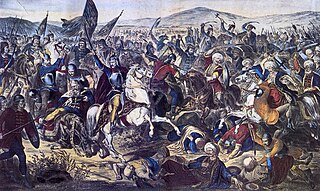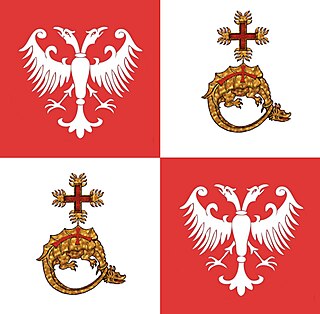
Murad I was the sultan of the Ottoman Empire from 1362 to 1389. He was the son of Orhan Gazi and Nilüfer Hatun. Murad I came into the throne after his elder brother Süleyman Pasha's death.

Murad II was twice the sultan of the Ottoman Empire from 1421 to 1444 and again from 1446 to 1451.

The 14th century lasted from 1 January 1301 to 31 December 1400 (MCD). It is estimated that the century witnessed the death of more than 45 million lives from political and natural disasters in both Europe and the Mongol Empire. West Africa experienced economic growth and prosperity.
The 1380s was a decade of the Julian Calendar which began on January 1, 1380, and ended on December 31, 1389.
The 1350s was a decade of the Julian Calendar which began on January 1, 1350, and ended on December 31, 1359.
The 1360s was a decade of the Julian Calendar which began on January 1, 1360, and ended on December 31, 1369.
Year 1365 (MCCCLXV) was a common year starting on Wednesday of the Julian calendar.
Year 1388 (MCCCLXXXVIII) was a leap year starting on Wednesday of the Julian calendar.
Year 1334 (MCCCXXXIV) was a common year starting on Saturday of the Julian calendar.
The 1390s was a decade of the Julian Calendar which began on January 1, 1390, and ended on December 31, 1399.
The 1370s was a decade of the Julian Calendar which began on January 1, 1370, and ended on December 31, 1379.
Year 1377 (MCCCLXXVII) was a common year starting on Thursday of the Julian calendar.
Year 1390 (MCCCXC) was a common year starting on Saturday of the Julian calendar.

The Battle of Kosovo took place on 15 June 1389 between an army led by the Serbian Prince Lazar Hrebeljanović and an invading army of the Ottoman Empire under the command of Sultan Murad Hüdavendigâr.

The rise of the Ottoman Empire is a period of history that started with the emergence of the Ottoman principality in c. 1299, and ended circa 1453. This period witnessed the foundation of a political entity ruled by the Ottoman Dynasty in the northwestern Anatolian region of Bithynia, and its transformation from a small principality on the Byzantine frontier into an empire spanning the Balkans, Anatolia, Middle East and North Africa. For this reason, this period in the empire's history has been described as the "Proto-Imperial Era". Throughout most of this period, the Ottomans were merely one of many competing states in the region, and relied upon the support of local warlords Ghazis and vassals (Beys) to maintain control over their realm. By the middle of the fifteenth century the Ottoman sultans were able to accumulate enough personal power and authority to establish a centralized imperial state, a process which was brought to fruition by Sultan Mehmed II. The conquest of Constantinople in 1453 is seen as the symbolic moment when the emerging Ottoman state shifted from a mere principality into an empire therefore marking a major turning point in its history.

Hayam Vuruk (1334–1389), also called Rajasanagara, Pa-ta-na-pa-na-wu, or Bhatara Prabhu after 1350, was a Javanese Hindu emperor from the Rajasa Dynasty and the 4th emperor of the Majapahit Empire. Together with his prime minister Gajah Mada, he reigned the empire at the time of its greatest power. During his reign, the Hindu epics, the Ramayana and the Mahabharata, became ingrained in the culture and worldview of the Javanese through the wayang kulit. He was preceded by Tribhuwana Wijayatunggadewi, and succeeded by his son-in-law Wikramawardhana.
The names of people, battles, and places need to be spelled as they are on other articles title and then wikified.

Moravian Serbia, the Principality of Moravian Serbia or the Realm of Prince Lazar are the names used in historiography for the largest and most powerful Serbian principality to emerge from the ruins of the Serbian Empire (1371). Moravian Serbia was named after Morava, the main river of the region. The independent principality in the region of Morava was established in 1371, and attained its largest extent in 1379 through the military and political activities of its first ruler, prince Lazar Hrebeljanović. In 1402 it was raised to the Serbian Despotate, which would exist until 1459.

Vikramavardhana (Indonesian : Wikramawardhana), regnal name Bhra Hyang Wisesa was a Javanese emperor and succeeded Rajasanagara Dyah Hayam Wuruk as the fifth monarch of the Majapahit empire, reigning from 1389 to 1429.

The fall of the Serbian Empire was a decades-long process in the late 14th century. Following the death of childless Emperor Stefan Uroš V in 1371, the Empire was left without an heir and the magnates, velikaši, obtained the rule of its provinces and districts, continuing their offices as independent with titles such as gospodin, and despot, given to them during the Empire. This period is known as the dissolution or the beginning of the fall of the Serbian Empire.








